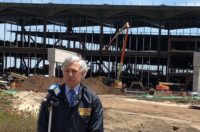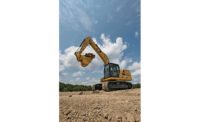An anticipated gradual easing of the decade-long surge in heavy equipment sales in 2020 turned into a nosedive as the pandemic’s clampdown on construction activity fueled across-the-board drops in U.S. demand. While manufacturers appear to have weathered the worst of the COVID-19 crisis, with sales largely stabilized, opinions differ on the scale and speed of the market’s recovery.
Following two years of better-than-expected sales performance coupled with the unpredictability that typically accompanies a pending national election, “we knew 2020 wasn’t going to be a great year,” says Association of Equipment Manufacturers President Dennis Slater. He adds that as many contractors closed out 2019 with healthy project backlogs, “we figured the market would plateau.”
That calculus quickly shifted in the spring as states and localities began restricting business activity to control coronavirus spread.
With construction allowed to continue in most locations amid tighter worker safety requirements, the need for new equipment did not evaporate entirely. “Overall, our members say business was slower but not devastating,” says Associated Equipment Distributors CEO Brian McGuire.
Global mining and construction equipment unit sales will fall 18% due to COVID-19 impacts, but they are set to grow at a compund annual growth rate of 0.84% for the next ten years, says business and economics research firm Frost & Sullivan in a Dec. 17 outlook. The firm estimates a $273-billion global rental market by 2030, "driven by the need to manage operational costs and increase utilization rates."
Frost & Sullivan says "growth will be driven by the Asia-Pacfic market and the earthmoving segment in the short term. The transition toward rental models, electirification and automation will happen in the medium to long terms."
As the year’s trends came into focus via fall earnings reports, manufacturers tempered their pessimism. Caterpillar reported a 23% decrease in third-quarter sales compared with the same period in 2019, but Chairman and CEO Jim Umpleby asserted that results “largely aligned with our expectations, and we’re encouraged by positive signs in certain industries and geographies.”
John Deere countered a 9% full-year drop in worldwide net sales and revenue with a 5% rise in fourth-quarter net income, which it credited to “strong execution and disciplined cost management.” Deere and Terex were among manufacturers that implemented short-term production pauses this year at selected facilities in response to decreased demand.
|
Related Link |
Emergency Response
In the rental sector, emergency response efforts helped mitigate Sunbelt Rentals’ U.S. rental-only revenue losses to 8%, according to the U.K.-based firm’s fiscal first-quarter 2021 earnings report, issued in early September.
The following month, United Rentals reported a 13.3% decrease in third-quarter rental revenue compared to 2019, with fleet productivity down 8%. Still, the company saw reason to limit its forecast full-year total revenue losses to 10% to 11%. CEO Michael Flannery stated that while the pace of the recovery remains uncertain, he saw “steady improvements” as reason for optimism.
Still, questions remain as to how these purported positive indicators will pan out in terms of demand and pricing for 2021 and beyond.
Even as hopes rise that the pandemic is on the brink of being brought under control, AEM’s Slater says any pent-up demand among contractors will be limited by depleted project pipelines.
“The first half of the year will definitely be pandemic-affected,” he says. Slater doesn’t expect manufacturers to pass along price hikes and says they may entice potential buyers with technology aimed at improving efficiency and capabilities that help them “do new things, or do current things better.”
Steve Tam, vice president of ACT Research Co., predicts that the replacement activity that helped drive 2020 sales will remain contractors’ purchasing priority. Citing advancements in safety technology, he adds that “they may feel it’s time to get rid of older equipment that’s not as well appointed.”
Upward Movement?
Chris Sleight of U.K.-based marketing consultant Off-Highway Research expects some upward movement in equipment costs, as excess inventory that added downward pressure on prices in 2020 has largely been cleared out. The resulting limited supply, combined with a forecast 10% increase in demand means “prices are likely to rebound,” Sleight adds. On the other hand, “interest rates will remain extremely low for several years, which is conducive to equipment purchasing.”
An emergency economic stimulus could also benefit the construction equipment sector, but Sleight worries that persistent partisan gridlock on Capitol Hill will blunt its potential benefit, and will “take longer to implement.”
Tam likewise harbors little hope of a full-fledged infrastructure bill in the first year of a Biden administration. But having the current funding formula extended for another year suggests “it will be business as usual in that sector, as most projects seem well-funded.”
Overall, he is mildly optimistic about the market’s 2021-22 prospects, “but we won’t set any records,” he says.





